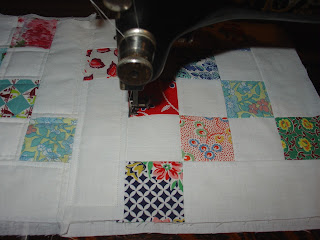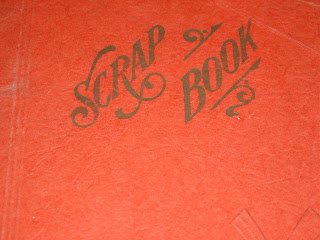I sewed along with my Jones handcrank (made in the 1920s, I think), making 4 patches from feedsack squares.
I started out using up scraps from my last feedsack project, the flying squares quilt. In that quilt, all four squares were different. In this quilt, I'm using two each of two prints. It was fun figuring out the combinations. Some are pretty and some are, well, not.
Here's the block the 4 patches will be part of. It's a pinwheel block, #1121 in Barbara Brackman's Encyclopedia of Pieced Quilt Patterns. I changed it a little, to make fewer seams. Doing so made it another block that needs a partial seam. If you'd like the pattern, leave a comment, and I'll write it up.
The most fun was just spending the day sewing together, catching up and chatting. We worked in the kitchen, because I'm not really set up to work in the basement with anybody else. I need to change that, I think. Although it was very convenient being near the food and beverages.
That evening we ate supper at the kitchen table and visited together. Then my husband and grandson watched a movie and my friend and I just talked. And laughed.
On Saturday we had a family birthday party for my youngest daughter. We brought in lots of chairs and packed around the table, and I bet they heard the laughing in Milwaukee. We did this at lunch and again at dinner, with a changing cast of characters. After dinner we played a charades game. More laughing, more fun, more sharing, around the kitchen table.
Sunday was a quieter day. Since I already had everything I needed for sewing handy, I set up again on the kitchen table, and finished the 4 patches. Then I started working on a charity quilt. My friend had given me a huge batch of 2.5 in. strips, cut from pillow panels. She had sewn lots of the strips into sets of 3, so it was easy for me to press, cut, and assemble 9 patch blocks. I'm wondering how many quilts I can make out of these strips.
I learned so much this weekend. My friend's insight into how to solve some of my quilting problems has made me think. I learned more about her life and the place quilting has in it. I learned that I can happily let go of stuff I've kept for years if it goes to a good place. And I'm trying not to worry so much about having the house "perfect" before I invite anyone over. Getting older is teaching me that life is NOW.
So thanks for coming over this weekend, family and friends. You are more than welcome here. I love to see you around my kitchen table.
 |
| Isn't this a great quilt top? Thanks, Joey! |



























